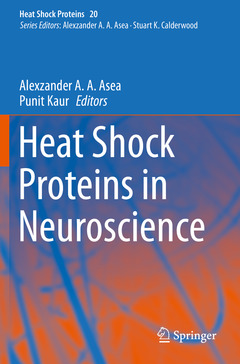Description
Heat Shock Proteins in Neuroscience, 1st ed. 2019
Heat Shock Proteins Series, Vol. 20
Coordinators: Asea Alexzander A. A., Kaur Punit
Language: English
Subject for Heat Shock Proteins in Neuroscience:
Publication date: 11-2020
307 p. · 15.5x23.5 cm · Paperback
Publication date: 11-2019
307 p. · 15.5x23.5 cm · Hardback
Description
/li>Contents
/li>Biography
/li>Comment
/li>
The book Heat Shock Proteins in Neuroscience provides the most comprehensive review on contemporary knowledge on the role of HSP in signaling pathways relevant to a number of diseases. Using an integrative approach, the contributors provide a synopsis of novel mechanisms, signal transduction pathways. To enhance the ease of reading and comprehension, this book has been subdivided into various section including; Section I, reviews current progress on our understanding of Neurological Aspects of HSP; Section II, focuses on Aspects of HSP in Neurodegenerative Diseases and Disorders, Section III, emphasizes the importance of HSP in Multiple Sclerosis; Section IV, reviews critical Aspects of HSP in Alzheimer?s Disease and Section V, gives a comprehensive update of the Development of HSP-Based Therapies for Neurological Disorders.
Key basic and clinical research laboratories from major universities, academic medical hospitals, biotechnology and pharmaceutical laboratories around the world have contributed chapters that review present research activity and importantly project the field into the future. The book is a must read for starters and professionals in the fields of Neurology and Neurosciences, Translational Medicine, Clinical Research, Human Physiology, Biotechnology, Cell & Molecular Medicine, Pharmaceutical Scientists and Researchers involved in Drug Discovery.
Section I: Neurological Aspects of HSP
Chapter 1. Hsp60 Friend And Foe Of The Nervous System
Antonella Marino Gammazza, Celeste Caruso Bavisotto, Francesca Rappa, Federica Scalia, Everly Conway de Macario,Alberto JL Macario andFrancesco Cappello
Department of Experimental Biomedicine and Clinical Neurosciences
University of Palermo
Palermo, Italy
Chapter 2.Role Of Heat Shock Proteins In Brain Tumors
George A. Alexiou
Department of Neurosurgery
University Hospital of Ioannina
Ioannina, Greece
Chapter 3.Body Temperature Regulation Determines Immune Reactions And Species Longevity
Ian James Martins
School of Medical Sciences
Edith Cowan University
Western Australia, Australia
Chapter 4.Interaction Between Heat Shock Proteins And Components Of The Plasminogen Activator System In The Central Nervous System
Mario Gonzalez-Gronow and Salvatore V.P izzo
Department of Biological Sciences, Laboratory of Environmental Neurotoxicology
Universidad Católica del Norte
Coquimbo, Chile
And
Department of Pathology
Duke University Medical Center
Durham, USA
Chapter 5. Role Of HSP70 In Plasticity And Memory
Rossana Rosa Porto and Lucas De Oliveira Alvares
Neurobiology of Memory Laboratory
Biophysics Department
Biosciences Institute
Chapter 6.Role Of Heat Shock Proteins (HSP) In Neuroprotection For Ischemic Stroke
Jong Youl Kim, Jong Eun Lee and Midori A. Yenari
Department of Neurology
University of California, San Francisco & the San Francisco Veterans Affairs Medical CenterSan Francisco, USA
Section II: Aspects of HSP in Neurodegenerative Diseases and Disorders
Chapter 7. Dysregulation Of Heat Shock Proteins In Neurodegenerative Diseases: Restorative Roles Of Small Molecules And Natural Compounds
Panchanan Maiti and Jayeeta Manna
Department of Psychology
Central Michigan University
Mt. Pleasant, USA
Chapter 8.Molecular Chaperones And Protein Quality Control System In The Canine Model Of Brain Aging And Neurodegenerative Diseases
Romanucci Mariarita and Leonardo Della Salda
Veterinary Pathology Unit, Faculty of Veterinary Medicine
University of Teramo
Teramo, Italy
Chapter 9.Role Of Hsp90 Interacting Molecular Chaperones On Tau And Aß Processing In Alzheimer’s Disease
Liam Gracia, Gabriella Lora and Umesh K. JinwalDepartment of Pharmaceutical Sciences
Byrd Alzheimer’s Institute, College of Pharmacy
University of South Florida-Health
Tampa, USA
Section III: Aspects of HSP in Multiple Sclerosis
Chapter 10.Role Of Hsp70 In Multiple Sclerosis: An Overview
Maria Magdalena Barreca and Fabiana Geraci
Department of Biological, Chemical and Pharmaceutical Sciences and Technologies
University of Palermo
Palermo, Italy
Chapter 11. Protective Role Of Glial Heat Shock Proteins In Amyotrophic Lateral Sclerosis
Benjamin E. Clarke, Bernadett Kalmar and Linda Greensmith
UCL Queen Square Institute of Neurology
London, UK
Section IV: Development of HSP-Based Therapies for Neurological Disorders
Chapter 12.Therapeutic Drugs And Natural Products: The Effect Of Suppressing Hsps In Brain Tumors
Elif Mertoğlu, Aslıhan Şengelen, Ezgi Kıyga and Evren Önay Uçar
Department of Molecular Biology & Genetics
Istanbul University
Istanbul, Turkey
Chapter 13.Can HSP Targeted Gene Therapy Be A New Hope for Gliomas?
Evren Önay-Uçar, Aslıhan Şengelen, Elçin Güngör, Elif Mertoğlu, Murat Pekmez and Nazlı Arda
Department of Molecular Biology & Genetics
Istanbul University
Istanbul, Turkey
Chapter 14.Therapeutic Aspects Of Heat Shock Proteins In Glioma: Cementing The Crevasses Between Bench And Bedside
Y.Rajesh, Utkarsh and Mahitosh Mandal
School of Medical Science and Technology
Indian Institute of Technology
Kharagpur, India
Chapter 15.Engineering Chaperones For Alzheimer’s Disease: Insights From Drosophila Models
Alfonso Martín-Peña and Diego E. Rincon-Limas
Department of Neurology
McKnight Brain Institute
University of FloridaGainesville, FL
Chapter 16.Role Of HSP In The Treatment Of Internal Dıseases
Ferda Hosgorler, Ozden Yildirim Akan and Pınar Kurçeren Ortan
Division of Neurology
SB University Izmir Bozyaka Training and Research HospitalAlsancak Izmir/TURKEY
Dr. Punit Kaur is an expert in onco-proteogenomics, with extensive training and experience in quantitative mass spectrometry imaging, protein chemistry and biomarker discovery. Dr. Kaur’s main research focus is on the use of heat-induced nanotechnology in combination with radiotherapy and chemotherapy in the cancer stem cell therapy. Dr. Kaur has published more than 40 scientific articles, book chapters, and reviews, and currently serves as editorial board member for the European Journal of Cancer Prevention and the Journal of Proteomics and Bioinformatics. Dr. Kaur is an editor of 9 books in the highly successful Heat Shock Proteins book series by Spring
Provides the most comprehensive review of contemporary knowledge on the role of HSP in signaling pathways relevant to a number of diseases
Contains chapters contributed by specialists from key basic and clinical research laboratories at major universities, academic medical hospitals, biotechnology and pharmaceutical laboratories around the world
An important source of reference for researchers, postdoctoral fellows and graduate students in the fields of Translational Medicine, Clinical Psychology, Human Physiology, Zoology, Botany, Biotechnology, Molecular Medicine, Infectious Disease, Pathology and Pharmaceutical Sciences, as well as for researchers involved in Drug Discovery




